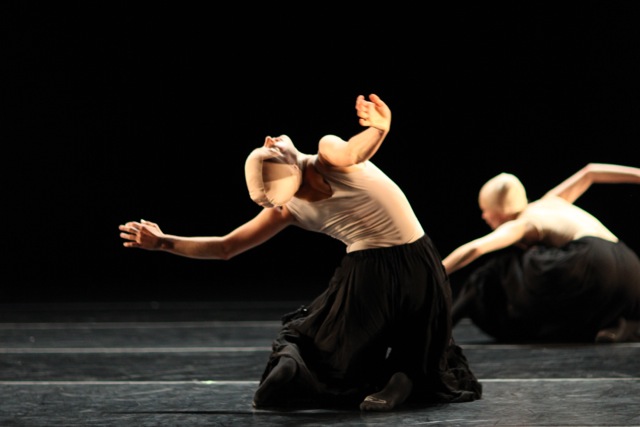
TU Dance’s rousing 10th anniversary season shows a company at the top of its game
TU Dance (a Knight Arts grantee) marked its10th anniversary season last weekend with an evening of four works, two of them world premieres, in the grand performance hall of the Cowles Center for Dance and the Performing Arts in Minneapolis.
The St. Paul-based company began with an elegant new contemporary ballet piece, “If and Or” by New York-based choreographer Dwight Rhoden. Both music and gestures are expansive – torsos open and arms wide-stretched, the tilted dip and curve of shoulder and hip anchored by the steadfast axis of legs held firm. Costumed simply in leotards with the green and loam hues of a springtime forest, the dancers reach for each other, their limbs entwining fluidly over, under, around before drawing away. The shifting pairs’ movements aren’t in synchrony so much as they are in intimate conversation — each exquisitely responsive to the others, but individual, too. The orchestration builds from contemplative melodies to something like jubilation, and the dancers’ movements follow: those once-taut alignments loosen from time to time — a moment’s jangle of arms from loose shoulders, their entanglements more frenetic – which makes the return of restrained balletic gestures at the work’s through-line all the more moving. It’s as if, by those deliberate lapses, they’re highlighting the joy, the abandon, humming just beneath the surface.
The vibe shifts with the second premiere of the night, “Keep the Edges Wild,” by another New York choreographer, Gregory Dolbashian. The dancers’ movements are serpentine, sinewy and sleek – hips swivel and undulate, shoulders swing low and rise effortlessly. Their pairings are athletic, by turns acrobatic and sensual. They couple up, then part, pushed and pulled as if by intersecting orbits — the embodiment of carnal longings frustrated, and then satisfied. By the end, we who are watching are as breathless as the dancers must be from the relentless build of tension; an audience member whoops loudly at the work’s kinetic climax, and it feels totally appropriate. In addition to the two new works, the concert featured “Rasa” (a 2007 duet by San Francisco-based Alonzo King). Against an atmospheric backdrop of tabla and traditional South Asian vocals by Zakir Hussain, Katelyn Skelley and Duncan Shultz offer a fluid, restrained but sensual enactment of the vicissitudes of desire, the bittersweet savor of romantic love.
The night finished with a 2012 work choreographed by TU Dance co-founder Uri Sands: “January (Part 2).” The mood pivots from fleshly concerns to those of the spirit. The stage is deeply shadowed, fogged; a single dancer emerges into the light, playing a Tibetan singing bowl. The others follow in the wake of the bowl’s keening, with the deliberate pace of mendicants. The dancers appear genderless – hair covered in skullcaps, men and women costumed alike, with fitted tops and dark billowing pants. And then, they’re dervishes: whirling, their arms extended, sweeping in and out of light and darkness as they spin past one another on the stage. As one, they hunch over — humped and plodding — and then they rise (perhaps redeemed?), limbs slowly unfurled as if emerging from a chrysalis. A pod of three or four breaks off from the group; they approach the edge of the stage, their toes flirt with the brink between audience and performance. They dip, crouch and lean – almost to the point of falling from the edge – and then spring up, like marionettes caught up by unseen hands above. It’s as if they are leaps of faith personified – risk and relief, risk and relief, the emotional swings of each palpable, yet undiminished by the repetition.
The evening’s works were as remarkable for their vulnerability and emotional nuance as for the undeniable technical prowess evident in their execution. At 10 years, TU Dance is a company at the top of its game.
For more information about TU Dance, and future performances, visit the website: http://www.tudance.org/. “January (Part 2),” 2012, choreographed by Uri Sands. Photo courtesy of TU Dance.
Recent Content
-
Artsarticle ·
-
Artsarticle ·
-
Artsarticle ·

